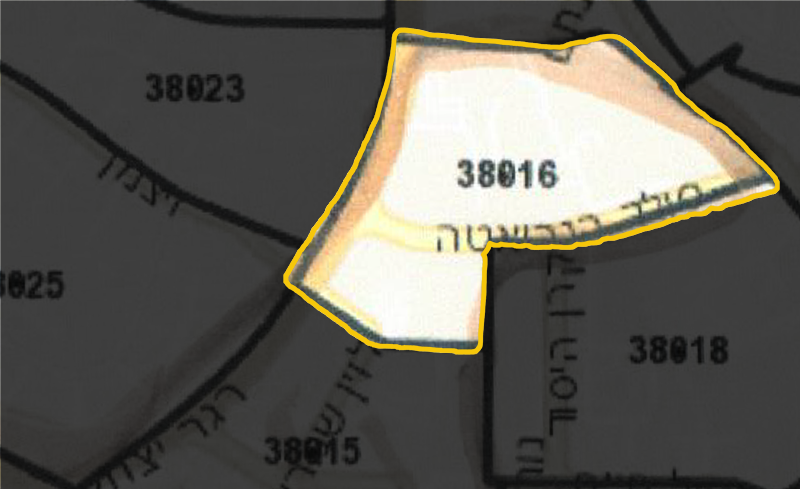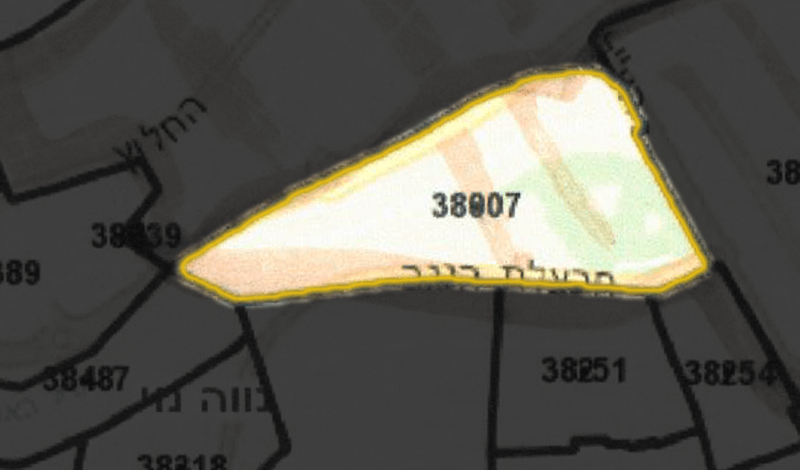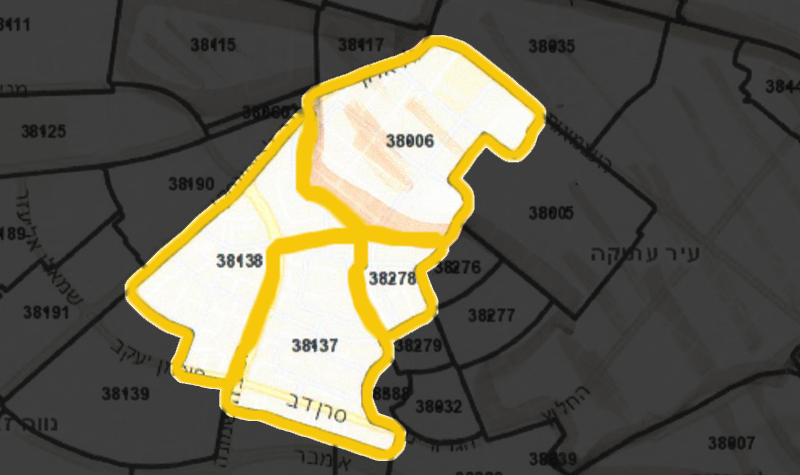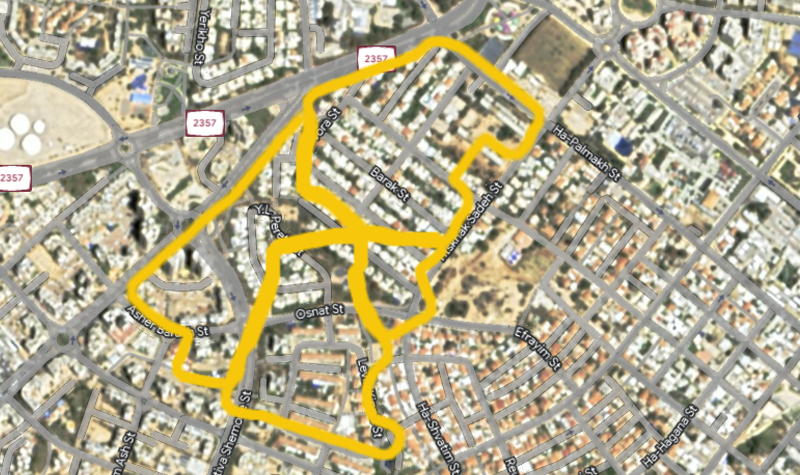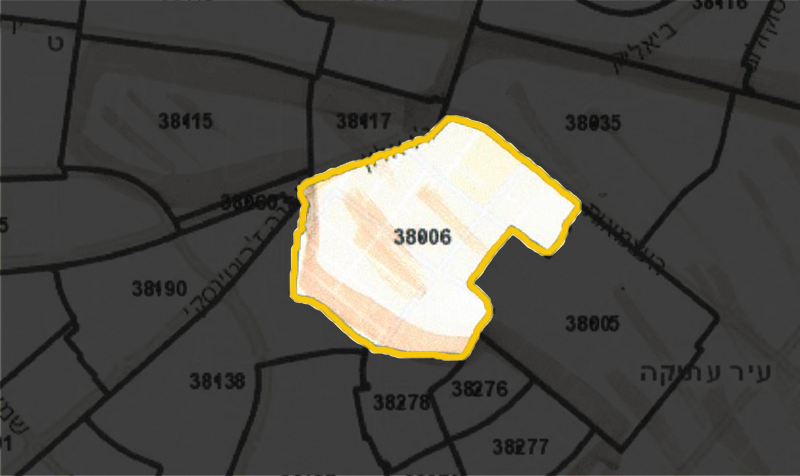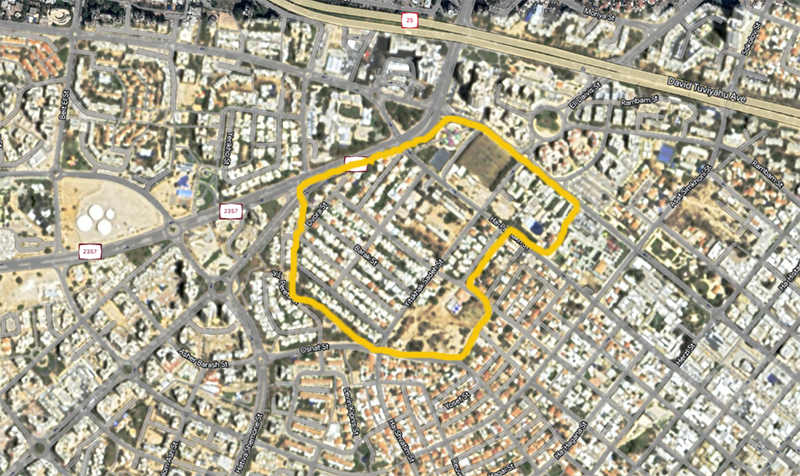Led and commissioned by Adel Bseiso, a team of historians, legal experts, and surveyors have contributed expert insight and pertinent research to trace the movement of a fraction of Mahrous Bseiso’s properties over time since 1948.
The map provided below depicts an overall view of the area in Beersheba, where many of his properties were located. The map is overlaid with satellite imagery of the present Beersheba to give context to the lost/stolen properties’ values and locations.
The following text offers detailed insights into the blocks documented within these archives and the current use of the land today. This information has been garnered through historical research from registrar offices across multiple countries, as well as legal research into the chain of custody of the various plots and parcels documented within this site.
Relevant Area of Discussion
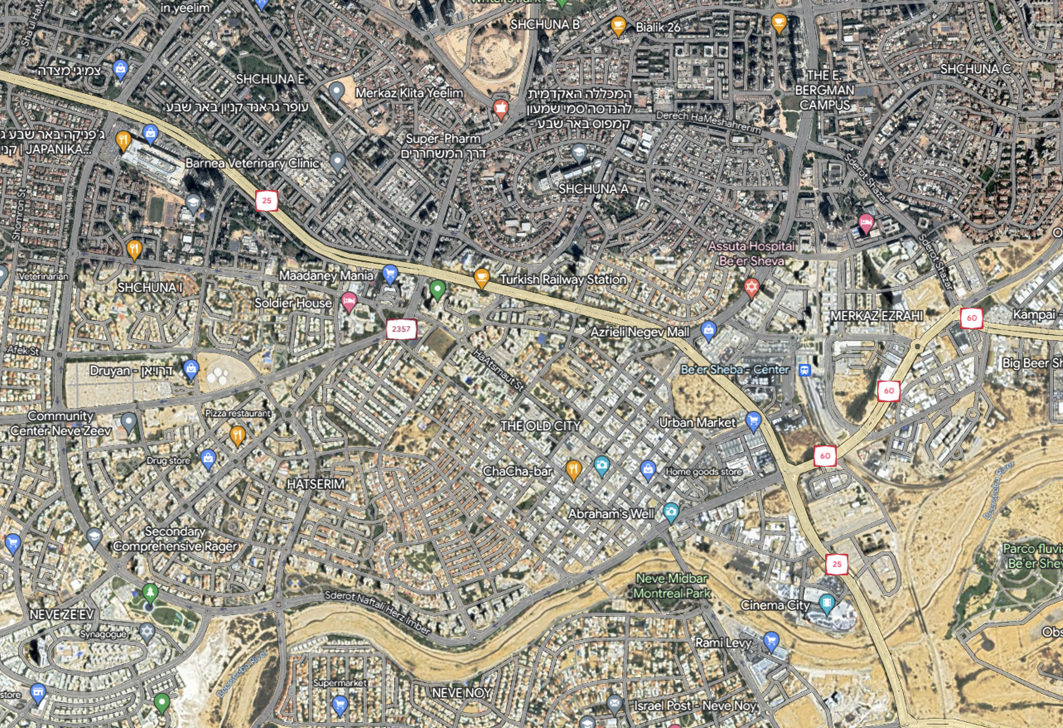
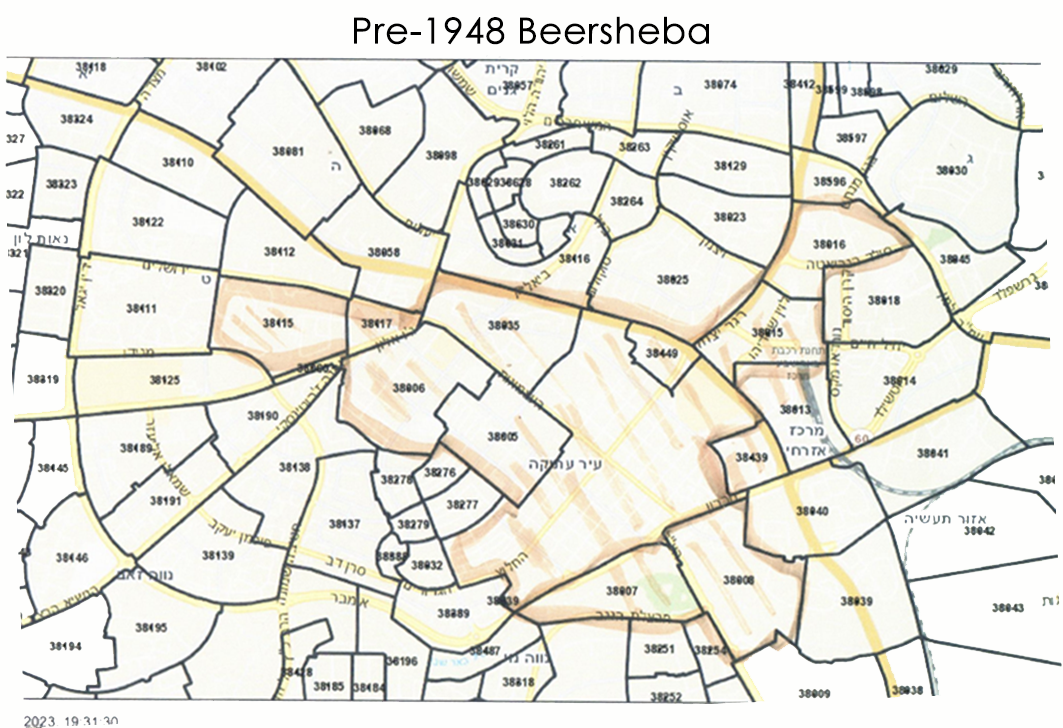
Legal Opinion Letter
By Jonathan Kuttab
I have been requested to convey my opinion regarding the historical land deeds held by the Bseiso family, concerning the numerous plots of land they owned in Palestine and that were seized by the Israeli State after 1948.
The following is my opinion:
Since 1948, the State of Israel has been establishing legal mechanisms that allow it to take over Palestinian property “legally”. Laws were put into place to ensure all the lands were taken “legally” and used exclusively for Jewish settlement. Israel established the Ministerial Committee for Abandoned Property in July 1948, as well as a Custodian of Abandoned Property, thereby enabling the state to arrange for the use of the land by Jews. The justification presented was that the State of Israel was acting as a guardian and trustee on behalf of Palestinians who were no longer there. Jordan also established the office of Custodian of Enemy Property, and has been faithfully safeguarding the property of Jews in Jordan since 1948. Theory and justification aside, Israel proceeded to use Palestinian property as its own for its Zionist project. After all, it was challenging to create a Jewish state when the vast majority of the property was held by non-Jews. Palestinian property was gradually given to kibbutzim, Jewish corporations, businesses, and individuals who collected abandoned grain fields and so on. As for the homes in deserted communities, the Israeli government and army began demolishing homes and other structures in hundreds of villages as early as 1948.
The adoption of the Emergency Regulations Regarding Absentee Property on December 2, 1948, signified a dramatic shift in Israeli attitudes towards refugees’ land and other properties. The legal emphasis switched from property to the refugee owner. Thus, unlike previous laws that offered the state legal jurisdiction to collect goods abandoned in a specific location, this new legislation allowed the state to seize all property, wherever it lay, that belonged to a person who fulfilled the criteria of an “absentee.” The seized property could then be transferred to others.
An absentee was defined as someone who was a citizen of an Arab state, was in an Arab country, was in any part of Palestine that was not under Jewish control, or was “in any place other than his habitual residence, even if such a place as well as his habitual abode were within Israeli-occupied territory” on or after November 29, 1947. As a result, “absentee” was a broad term that permitted the Israeli government to seize the land and other property of a wide range of people who were not refugees in the conventional sense of the word. In reality, the rule allowed for the seizure of a person’s land and other property even if he or she lived in Israeli-occupied territory, departed for a day to another location inside Israeli-occupied territory, and then returned. The idea that the Custodian was holding the land on behalf of these people, who still existed in the land, is ludicrous. It led to the phenomenon of the “present absentee,” who could be legally prosecuted for trespassing on his own land since he was present for criminal jurisdiction purposes, but an “absentee” when determining the legal possession of his land now held by the state.
The Knesset passed the Absentee Property Law on March 14, 1950, which was a modified version of the Emergency Regulations Regarding Absentee Property. One significant new clause authorized the Custodian of Absentee Property to sell confiscated refugee land to a new organization, the Development Authority, for the first time. In theory, if the land was “sold,” the Custodian would continue to hold the proceeds in trust for the absentee. In reality, no such funds have been documented or tracked, and the lands were simply given to various quasi-public bodies to hold on behalf of all Jews globally.
This situation was created by the Development Authority (Transfer of Property) Law, which was passed on August 9, 1950. The Development Authority was given authority by the legislation to sell land to the State or the Jewish National Fund (JNF), an organization whose holdings are solely earmarked for Jewish people. Because of this “legal” mechanism of disowning the absentee, and throughout the early 1950s, the Custodian worked to legally register refugee land in new Israeli land registers and sold a significant amount of this land to the Development Authority. The Development Authority, in turn, did not retain permanent control over all of it but sold it to the JNF. In 1960, the state and the JNF agreed to transfer all the property they independently controlled under the jurisdiction of the Israel Lands Authority (ILA).
As a result, the majority of remaining refugee lands and structures are registered to the Israeli state, the Development Authority, or the JNF. As such, they remain under the supervision of the Israel Land Authority Council (ILAC), the Israel Land Administration’s new name (as designated in the Israel Land Administration Law of August 2009). They also transferred property in the middle of cities and towns to the local Jewish municipalities. The Israel Land Administration Law of August 2009 permitted the ILAC to “sell” (i.e., privatize) a specified percentage of ILA-controlled territory. Part of this process is the JNF exchanging urban land it controls for rural land, which is subsequently sold to private individuals. As a result, Palestinian refugee land can now be sold to private individuals. This process placed another layer of distance between the original owner and the current holder of the property. So, if the original owner could theoretically challenge the transfer of his rights in the property, he would face a different holder who could claim to have “bought” the land innocently from a government authority (the Custodian) and therefore is not required to relinquish it.
The stolen lands were used to build Jewish settlements, create new agricultural areas, and so forth. Some refugee land is still abandoned and deserted today. Some of these village grounds still have abandoned Palestinian houses and other structures. In cities and towns, refugee lands are worth substantial sums of money.
The Bseiso lands in Beersheba are a living example of the various methods used to seize the lands of the Palestinians in 1948 “legally.” They were transferred to various institutions and then obscured through various registration procedures and techniques, such as re-registration and reparcellization.
The Bseiso family owns a large number of properties in prime locations in the city center of Beersheba today – lands whose value is tremendous under current prices.
The lands were taken in 1948 and transferred to the various Israeli institutions mentioned above in the decades that followed.
VOLUME 1 FOLIO 41 – This plot of land was transferred to the name of the Custodian of Absentee Properties on February 28, 1971.
VOLUME 1 FOLIO 51 – This plot of land was transferred to the name of the Custodian of Absentee Properties on February 28, 1971.
VOLUME 1 FOLIO 69 – This plot of land was also transferred to the name of the Custodian of Absentee Properties on February 28, 1971.
VOLUME 1 FOLIO 110 – This plot of land was transferred to the Custodian of Absentee Properties on February 28, 1971.
BLOCK 38016 PARCEL 15 ALSO KNOWN AS VOLUME 11 FOLIOS 95 – 97 – was transferred to the ownership of the Municipality of Beersheba on February 23, 1969, after a land settlement process.
BLOCK 38004 PARCEL 32 AKA VOLUME 10 FOLIO 64 was confiscated on September 16, 1956, and transferred to the Development Authority.
BLOCK 38004 PARCEL 33 AKA VOLUME 10 FOLIO 65 was confiscated on September 16, 1956, and transferred to the Development Authority.
BLOCK 38004 PARCEL 34 AKA VOLUME 10 FOLIO 66 was confiscated on September 16, 1956, and transferred to the Development Authority.
In conclusion, one can deduce that the lands mentioned above were taken in two stages – the lands of parcel 38004 were confiscated and transferred to the Development Authority a few years after the 1948 war as they were lands used for building in the center of town. They were also confiscated for public use to prevent any kind of claims (for instance, if an absentee turned out not to be an absentee and could show that he held a foreign passport before 1948, he would still be unable to reclaim his land or even properly locate it).
The Volume 1 plots were transferred to the Custodian of Absentee Properties on February 28, 1971, after the owner was declared an absentee and all his lands were transferred to the Custodian on the same day.
Many block and parcel numbers of the Bseiso family were changed in a settlement process, which makes it significantly more challenging to precisely follow what happened to this property.
Thus, for example, plot 38017 parcel 3 does not exist anymore. Block 38017 was merged with block 38007 and this is the number today and that this plot of land is a public park in the middle of Beersheba. Our ability to track down this property was assisted by the meticulous record keeping of the original owner, as well as by persistent efforts of his heirs. In the case of other Palestinian owners, the difficulties to be faced are insurmountable.
The plots of parcel 38006 have all been changed, and the current numbers do not correspond to the old block and parcel numbers kept by the family. The plots of parcel 38006 are today in current blocks 38006 (with different parcel numbers) and blocks 38278, 38137, and 38138.
This makes the process of trying to discover what happened to the lands significantly more challenging.
For example, Block 38016 parcels 3 and 4 are today parcels numbered 47 – 52. This plot, measuring around 8 acres in the city’s heart, does not show when it was confiscated or taken, and any record that it belonged to the Custodian (and therefore previously belonged to Palestinians is gone). Thus, the deeds simply show the dates that the lands underwent parcelization. Unlike the other volume and folio numbers, even if one checks the current deeds, it is impossible to discern the land’s original provenance (i.e., it does not mention the Custodian of Absentee Property or the Development Authority, etc.). Thus, the authorities effectively “cover their tracks”.
Until a few years ago, the historical records of such plots were open to the public, and therefore you could easily get a copy of the lands in the original owner’s name – it would be crossed out in red, and replaced by the Custodian’s name which would also be crossed out in red, and then the current owner’s name would be written.
Now, to prevent people whose lands were taken from easily proving the theft, even if they do not have any documentation, only the current ownership is open to the public. The authorities refuse to provide the historical records.
The fact that the confiscated land was transferred to the Development Authority signifies that the authorities considered it absentee land since this is one of the methods of preventing any claims. The land is transferred to the Custodian and then from the Custodian to the Development Authority – which is a fake authority set up to prevent the land from returning to their rightful owners even if the land turns out not to be absentee land in the end (and this is very rare in all cases since everyone is an absentee unless they were living in the Western countries before November 1947.) This allows the State of Israel to claim the land has already been transferred to a third party (the Development Authority) and therefore it cannot be claimed back.
An inspection of the deeds reveals most of the “techniques” mentioned above and used by the authorities were used in the case of the Bseiso family lands. The process is an ingenious effort to provide a legal/ethical alibi for mass theft of property. First, through the declaration of Palestinians to be absentees then by covering the evidence and only showing the current owners, so that even if Israel is somehow required in the future to reverse the process and return the land to its original owners, it can make the process of reclaiming the land nearly impossible. A key element in this grand scheme is the existence of bodies like the Jewish National Fund, which perform quasi-governmental functions, but which are also charged by their very articles of incorporation to hold land in perpetuity on behalf of Jews everywhere. The JNF is not allowed to sell the land to anyone but may grant a long-term lease and only to Jews. Non-Jews are not allowed to live on or work in JNF lands.
The JNF, originally a private corporation, became part of the state of Israel, and its lands and holdings were conflated with state land and public land. In a Jewish state, it was argued, such public lands could and should legally and legitimately serve Jews and Jews alone. Only recently has this practice been labeled Apartheid, and the inherently racist and discriminatory character of the state and its property acquisition been recognized as inherently unjust. The fact that even within the State of Israel, 20% of its citizens (who are not Jews) are systematically kept out of this supposedly public land cannot be justified. That such property, to begin with, did not belong to the state or to Jewish individuals at all but were private land of Palestinians who were forcibly removed and kept from enjoying their property is an added insult.
Present Day Beersheba

